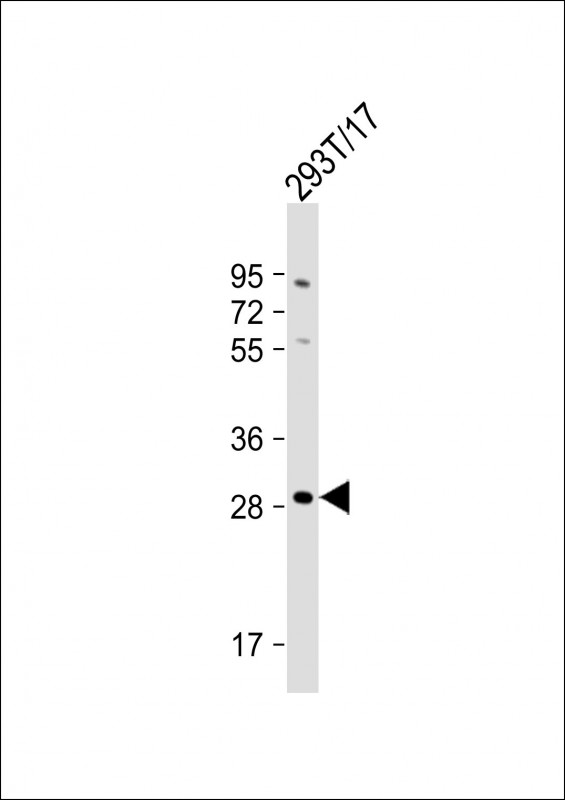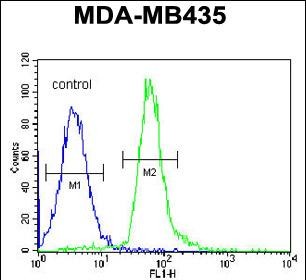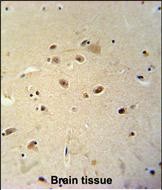




| WB | 1/1000 | Human,Mouse,Rat |
| IF | 咨询技术 | Human,Mouse,Rat |
| IHC | 1/100-1/500 | Human,Mouse,Rat |
| ICC | 技术咨询 | Human,Mouse,Rat |
| FCM | 1/10-1/50 | Human,Mouse,Rat |
| Elisa | 咨询技术 | Human,Mouse,Rat |
| Aliases | Ras-related GTP-binding protein D, Rag D, RagD, RRAGD (HGNC:19903) |
| Entrez GeneID | 58528 |
| WB Predicted band size | 45.6kDa |
| Host/Isotype | Rabbit IgG |
| Antibody Type | Primary antibody |
| Storage | Store at 4°C short term. Aliquot and store at -20°C long term. Avoid freeze/thaw cycles. |
| Species Reactivity | Human, Mouse |
| Immunogen | This RRAGD antibody is generated from rabbits immunized with a KLH conjugated synthetic peptide between 171-199 amino acids from the Central region of human RRAGD. |
| Formulation | Purified antibody in PBS with 0.05% sodium azide. |
+ +
以下是关于RRAGD抗体的3篇参考文献及其摘要概述:
---
1. **文献名称**:*Rag GTPases Mediate Amino Acid-Dependent Recruitment of TFEB and MITF to Lysosomes*
**作者**:Martina et al. (2019)
**摘要**:该研究揭示了RRAGD在调控TFEB/MITF转录因子溶酶体定位中的作用。作者使用RRAGD特异性抗体进行免疫沉淀和Western blot实验,证明RRAGD通过mTORC1信号通路响应氨基酸水平变化,影响自噬和溶酶体功能。
---
2. **文献名称**:*Structural basis for the docking of mTORC1 onto the lysosomal membrane regulated by amino acid availability*
**作者**:Su et al. (2017)
**摘要**:研究通过冷冻电镜和生化分析解析mTORC1与溶酶体膜结合的机制。文中利用RRAGD抗体验证Rag异构体复合物(含RRAGD)的组成,证实其在氨基酸感知及mTORC1激活中的关键作用。
---
3. **文献名称**:*Regulation of mTORC1 by the Rag GTPases: A mechanism for nutrient-sensing*
**作者**:Sancak & Sabatini (2009)
**摘要**:经典研究探讨Rag GTPases(包括RRAGD)如何调控mTORC1活性。作者通过RRAGD抗体检测其在细胞内的表达与定位,揭示其在能量/氨基酸信号转导中的核心地位,为后续靶向治疗提供理论基础。
---
这些文献均通过RRAGD抗体验证其在mTOR通路、溶酶体功能或营养感应中的分子机制,涵盖基础机制与结构生物学层面的研究。
The RRAGD antibody is a research tool used to detect and study the Ras-related GTP-binding protein D (RRAGD), a key component of the nutrient-sensing mTORC1 signaling pathway. RRAGD belongs to the Rag GTPase family, which regulates cellular responses to amino acid availability by shuttling mTORC1 to lysosomal surfaces for activation. This protein plays a critical role in coordinating cell growth, metabolism, and autophagy. Dysregulation of RRAGD or its associated pathways has been implicated in cancers, metabolic disorders, and neurodegenerative diseases.
Antibodies targeting RRAGD enable researchers to investigate its expression, localization, and interaction partners in various biological contexts. They are widely used in techniques like Western blotting, immunofluorescence, and immunohistochemistry to assess protein levels or subcellular distribution under different experimental conditions (e.g., nutrient deprivation, drug treatment). Validated RRAGD antibodies help clarify its tissue-specific functions, post-translational modifications, and mechanistic roles in mTORC1 signaling.
Commercial RRAGD antibodies are typically raised against specific epitopes, such as the N-terminal or C-terminal regions, and are often validated using knockout/knockdown controls to ensure specificity. Researchers rely on these reagents to explore RRAGD's contributions to diseases and its potential as a therapeutic target. Major antibody suppliers, including Santa Cruz Biotechnology and Cell Signaling Technology, offer RRAGD-specific reagents, emphasizing their importance in molecular and cellular biology research.
×